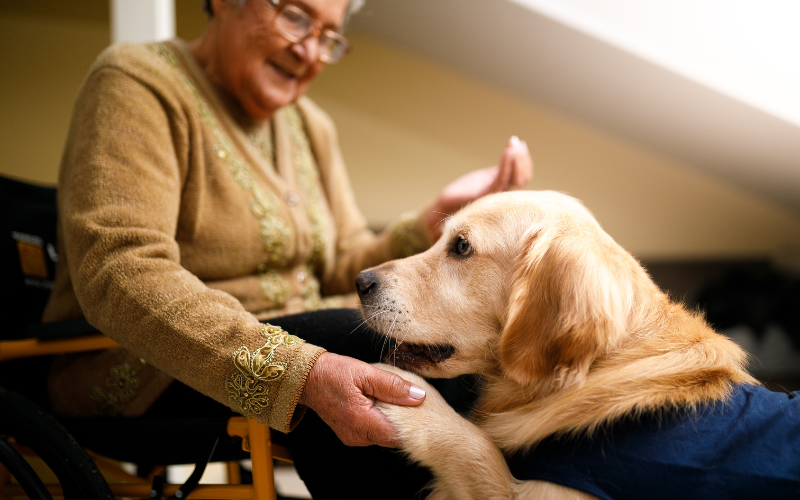September is Service Dog Month and Therapy Dog Awareness Month, a great time to highlight the positive impact dogs have on clients who need them and in the healing process. We asked Dr. McBride and her dog Krinkle to tell us more about combining EMDR therapy with Animal-Assisted Therapy (AAT).
Companions in Healing: Enhancing EMDR Therapy with the Comfort and Connection of Animals
Guest Blog Post by Dr. Samantha McBride, Psy.D.
Tell us a little bit about you, your experience becoming an EMDR therapist, and what led you to be interested in animal-assisted therapy (AAT).

Krinkle

Dr. Samantha McBride
I am a Licensed Clinical Psychologist based in Colorado, working with children, teens, and adults, specializing in trauma, anxiety, and depression. I completed EMDR Basic Training in 2014 and the following year became certified as part of a professional therapy dog team with my therapy dog, Krinkle. Since then, I’ve integrated animal-assisted therapy (AAT) with EMDR therapy, which has enriched my clinical practice in beautiful, powerful ways. I am also an EMDRIA Certified Therapist™, Consultant™, and Basic Trainer.™
I first became aware of the impact AAT can have on therapeutic work during graduate school, when a professor brought a therapy dog into the training clinic and it briefly interacted with a client I had been working with for over a year. In just a couple of minutes, I saw the client–a resilient adult with a complex trauma history that resulted in severe social anxiety–relax and connect with me in a way he hadn’t been able to access before. The therapeutic potential of therapy animals to support healing and growth was clear to me in that moment.
Can you briefly help us understand a little more about AAT and why it has become popular in therapeutic settings? What qualities in (your or other animals) seem to lend themselves to working with clients?
AAT is defined by Pet Partners (2019) as “a goal-oriented, planned, structured, and documented therapeutic intervention directed by health and human service providers as part of their profession. A wide variety of disciplines may incorporate AAT.” For our purposes, it involves mental health professionals using a therapy animal to support clients in achieving their mental health goals. While my personal experience is with a therapy dog, many other animals can also be used for AAT.
Therapy animals working with mental health professionals undergo specialized training to navigate both public interactions and specific situations that can occur in a therapy office, as these animals must consistently demonstrate a calm demeanor. Certification typically includes a behavioral assessment, which evaluates the animal’s temperament and training in a variety of situations, such as in a busy waiting room or around raised voices. The role of therapy animals is distinctly different from other assistance animals, such as service and emotional support animals.
The power of connection in the therapeutic relationship and its role in facilitating treatment progress is undeniable. When we consider the human-animal bond, new pathways emerge to foster connection and subsequent progress, especially for individuals who may view animals as safer or easier to engage with than people. I’ve worked with multiple clients, particularly teenagers with prior negative therapy experiences, skepticism about the process, or Autism diagnoses, who only agreed to start therapy because of the presence of the therapy dog. One recent example comes to mind—a teenage client I saw for a first appointment whose parents scheduled the appointment despite her belief that therapy wouldn’t be effective. We met virtually, and when I mentioned that I have a therapy dog in my office, her face lit up with a smile (the only one during the entire meeting), and she agreed to start therapy. In a time when both therapists and clients are seeking client-centered, integrative, and individualized care, the addition of a therapy animal can be a compelling resource to support a variety of therapy goals. Even clients who are motivated to engage in the therapeutic process often find it easier to explore difficult topics while interacting with a therapy animal. VanFleet and Faa-Thompson (2017) highlight some benefits of AAT, writing, “in AAT, animals have been employed for rapport-building, decreasing anxiety, developing trust, fostering attachment, increasing openness, adding emotional safety, improving motivation, and developing physical, cognitive, emotional, and social competencies. Animals have served as catalysts for social interactions and to decrease resistance. Animal involvement in therapeutic processes has ranged from the mere presence of animals in a therapeutic setting to full incorporation of animals in a wide range of therapeutic tasks.” (p. 37)
Several qualities make therapy dogs particularly effective at their jobs. First, it is important for therapy animals to love the work they do and enjoy interacting with the population they serve. For the well-being of everyone involved, the animal should feel comfortable and exhibit a calm demeanor in the therapeutic environment and in various situations they might face (e.g., loud noises, rambunctious children, raised voices, and medical equipment). The therapy animal should have a personality that does not require constant attention, as the wishes of the therapy animal are secondary to the therapeutic process—meaning that the animal should be able to interpret some social cues and rest when not actively participating. Sensitivity to the emotional needs of clients is beneficial. Depending on the population with whom you work, certain qualities may present as particularly important. For example, since I was working with energetic, young children when I first got Krinkle, it was crucial to have a therapy dog who enjoyed young children, didn’t become overexcited by their attention, and was unfazed by yelling, rough petting, and poor boundaries.
How can EMDR therapy and AAT complement each other in treatment? What successes have you seen?
Using AAT to support EMDR therapy with a client may be my all-time favorite clinical work. Combining EMDR therapy’s incredible ability to heal trauma with the grounding presence of a therapy dog has led to many heartwarming therapeutic moments. One memory that stands out is of a child who was processing multiple traumas involving a close family member, which was emotionally taxing for her. The therapy dog was used to help support this client stay within her window of tolerance, ground, and re-regulate during EMDR reprocessing as well as closure. One day at the end of the session, she made up a song about Krinkle and walked through the clinic singing the song to other providers—a moment of lightness and connection that was touching to witness immediately following such challenging trauma work.

Krinkle’s Wall of Fame
VanFleet and Faa-Thompson (2017) emphasize that when treatment planning, client goals should first be defined. Then it can be determined if animal-assisted therapy can assist in meeting those goals. AAT is not based on a single theoretical orientation; instead, it can be flexibly integrated to support the therapist’s theoretical orientation and clinical model being used. This format can easily be applied so AAT can support EMDR therapy. I conceptualize EMDR therapy as providing the structure for clinical work—when we consider the AIP model, 8 phases, and 3 prongs, we can identify a clinical path that guides our work. Within that framework, AAT is one tool we can utilize to meet client goals and enhance the EMDR treatment plan.
Consider several ways therapy animals may be integrated into EMDR sessions:
- In EMDR resourcing exercises, the animal may serve as an ally or be part of the calm place visualization.
- As a standalone grounding resource—especially for clients who find less benefit in the traditional resourcing exercises.
- As a tool to support dual awareness and staying within the window of tolerance during phases 3 through 6, with the use of clinical judgement to determine the level of interaction that may be most beneficial, such as:
- Noticing the sound of the animal’s breath
- Having the animal sit on the client’s lap
- Petting the animal
- Engaging the animal in a trick and offering a treat
- Use of pictures or stories of the therapy animal—to teach skills, learn about and identify feelings, and access adaptive experiences.
- To identify and build on strengths or positive cognitions through interactions with the therapy animal.
AAT interventions can be applied across all 8 phases of EMDR therapy. In my experience, the therapy dog is most often used during the preparation, desensitization, and closure phases, but their presence can be beneficial throughout. The beauty of AAT is that the more creative we are in considering the therapeutic goal, our client, and the animal, the more possibilities we find to weave AAT into our work. Consider the ideas above as a starting point —suggestions to get your own ideas and creativity flowing.
What multicultural considerations might EMDR therapists need to keep in mind regarding EMDR therapy and AAT?
As with any therapeutic modality, AAT is not suitable for every client. It is important to recognize that cultural perspectives on animals, including dogs, can vary greatly. Consideration of each individual and their experience is essential before integrating an animal into therapeutic work. Some people may have fears, trauma responses, or allergies, so it is important to remain mindful of how the presence of a therapy animal may impact the client.
Are there any cautionary measures you would like to mention regarding using EMDR therapy and AAT?
Integrating a therapy animal into clinical practice can be an incredible therapeutic asset, but it also requires thoughtful preparation and planning. Mental health professionals interested in incorporating a therapy animal into their clinical practice should ensure that they and their animal receive appropriate training. While standards for therapy dogs are still evolving, it is important for the therapy dog and handler to be certified as a therapy dog team. Practitioners should carefully review agency policies, building policies or lease agreements, and liability insurance prior to introducing a therapy animal into a clinical space. Beyond those logistics, it is beneficial to proactively consider that the presence of a therapy animal introduces a new relational dynamic into the therapeutic environment, and clients might have a range of responses to the animal.
Anything else you would like to add?
The rise of telehealth has created a perfect opportunity to more broadly consider integrating AAT, even when therapists do not have access to a therapy animal in their office. Clients can engage their pets in animal-assisted therapeutic interventions from the comfort of their home with great benefit. Here are a few ideas:
- Mindfulness with the pet—guiding the client to notice sensory experiences (sight, sound, smell, and touch) related to the pet.
- Interaction with the pet during reprocessing sessions— as mentioned above, to support dual awareness, grounding, and nervous system regulation, such as through observation, petting, or sitting on the client’s lap.
- Using photos of the pet to support resource development or staying within the window of tolerance.
Samantha McBride, Psy.D., is a Licensed Clinical Psychologist and Assistant Professor at the Johnson Depression Center, part of the Department of Psychiatry at the University of Colorado’s School of Medicine. Dr. McBride is an EMDRIA Certified Therapist™, Consultant™, and Basic Trainer™. She works with youth and adults, often integrating animal-assisted therapy into her clinical practice.
References
Etheridge, H. (2019, July 9). A beginner’s guide to animal-assisted intervention terminology. Pet Partners. https://petpartners.org/a-beginners-guide-to-animal-assisted-intervention-terminology/
VanFleet, R., & Faa-Thompson, T. (2017). Animal-assisted play therapy. Sarasota, FL: Professional Resource Press.
Back to Focal Point Blog Homepage
Additional Resources
If you are a therapist interested in the EMDR training:
- Learn more about EMDR therapy at the EMDRIA Library
- Learn more about EMDR Training
- Search for an EMDR Training Provider
- Check out our EMDR Training FAQ
If you are EMDR trained:
- Check out the EMDRIA Let’s Talk EMDR Podcast
- Check out the EMDRIA Focal Point Blog
- Learn more about EMDRIA membership
- Search for EMDR Continuing Education opportunities
If you are an EMDRIA™ Member:
- Learn more about EMDR Consultation
- Find clinical practice articles in the EMDRIA Go With That Magazine®
- Search for articles in Journal of EMDR Practice and Research in the EMDRIA Library
Date
September 19, 2025
Contributor(s)
Samantha McBride
Practice & Methods
Animal-Assisted Therapy, Your EMDR Practice





